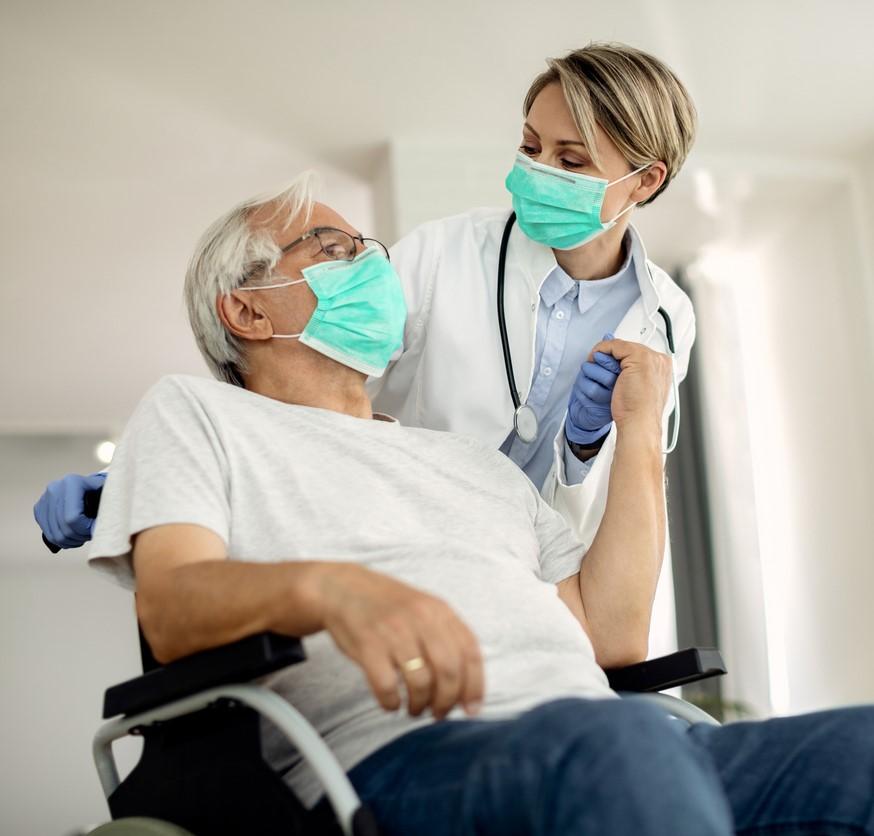Three studies on COVID-19 prevention in nursing homes published today in Morbidity and Mortality Weekly Report suggest that regular testing of residents and staff to identify asymptomatic infections may help contain outbreaks and that Centers for Medicare & Medicaid Services (CMS) star ratings could serve as a proxy for coronavirus outbreak risk.
Key role for serial testing
The first study, by researchers at the Minnesota Department of Health and the Centers for Disease Control and Prevention (CDC), found that weekly universal COVID-19 testing at two Minnesota skilled nursing facilities (SNFs) from April to June detected infections in 64% of residents and 33% of healthcare providers (HCPs).
Genetic sequencing of the viruses showed facility-specific clustering of genomes from both resident and staff specimens, suggesting transmission within the nursing home.
Of 259 residents tested, 166 (64%) were positive for COVID-19, as were 114 (33%) of 341 HCPs; of the 114 HCPs testing positive, 4 (4%) were hospitalized, and 2 (2%) died.
Before serial testing was done at facility A from Apr 30 to May 18, 14 of 78 residents (18%) tested positive for COVID-19. Three rounds of testing detected coronavirus infection in 51 of 77 residents (66%), of whom 14 (27%) were hospitalized, and 12 (24%) died.
Before serial testing, 15 of 150 (10%) of HCPs tested positive for COVID-19 at visits to their individual health professionals. In three rounds of testing, 51 of 199 HCPs (26%) were diagnosed as having a coronavirus infection.
At facility B, 24 of 183 residents (13%) tested positive for COVID-19 after having symptoms or being identified as a roommate contact of an infected resident. During six rounds of testing at the nursing home from May 7 to Jun 11, 114 of 182 residents (63%) tested positive, of whom 19 (17%) were hospitalized, and 40 (35%) died.
Of 324 HCPs tested at facility B from May 1 to Jun 12, 76 (33%) tested positive. Results of the initial tests were delayed for as long as 12 days.
In-facility virus transmission could have been caused by lack of vigilance in infection prevention and control (IPC) protocols, delays in getting test results at one facility, and participation by only 71% of HCPs, the authors noted.
Serial testing of all residents and staff until no new infections are detected for 14 days and strengthening infection-control protocols are critical in nursing homes, the researchers said.
"Residents and HCP working in SNFs are at risk for infection with SARS-CoV-2," the authors wrote. "As part of comprehensive COVID-19 preparation and response, including early identification of cases, SNFs should conduct serial testing of residents and HCP, maximize HCP testing participation, ensure availability of personal protective equipment (PPE), and enhance IPC practices."
Early case identification
In the second study, Fulton County, Georgia, public health officials and the CDC gauged the timing of mass testing in relation to COVID-19 infections at 28 nursing homes.
Universal testing in the county's nursing homes began after the first coronavirus outbreak occurred in a nursing home in March. Because of limited testing supplies and staffing capacity, universal testing at first took place only in nursing homes with at least one confirmed COVID-19 case, then expanded to all facilities.
Universal testing found a 28.0% prevalence of COVID-19 in residents and 7.4% prevalence in HCPs at 15 nursing homes that didn't test until a COVID-19 case was identified, suggesting that the virus had already spread before the first case was identified. At 4-week follow-up testing, 42.4% of residents and 11.8% of HCPs tested positive for coronavirus infection.
In contrast, 13 facilities that conducted testing before a case was detected had only a 0.5% prevalence of COVID-19 in residents and 1.0% in staff. At follow-up, 1.5% of residents and 1.7% of staff were found to be infected.
Of the 985 diagnosed as having COVID-19 during and after universal testing at nursing homes, 164 (16.6%) were hospitalized, and 113 (11.5%) died. Among the 164 hospitalized COVID-19 patients, 158 (96.5%) were from facilities that conducted facility-wide testing only after a case was identified.
"These findings indicate that early awareness of infections might help facilities prevent potential outbreaks by prioritizing and adhering more strictly to infection prevention and control (IPC) recommendations, resulting in fewer infections than would occur when relying on symptom-based screening," the authors said.
High ratings, lower risk
The third study evaluated the association between the CMS Five-Star Quality Rating System, which awards stars to CMS-certified nursing homes based on health inspection results and quality ratings, and the risk of COVID-19 outbreaks at 123 West Virginia nursing homes from Mar 17 to Jun 11.
The researchers used data from the West Virginia Department of Health and Human Resources to identify COVID-19 outbreaks at 14 of 123 nursing homes (11%) involving 226 residents and 140 staff. Seven of the 14 outbreaks (50%) occurred at facilities with one-star ratings.
The odds of a coronavirus outbreak were 87% lower among facilities with a two- or three-star rating and 94% lower among facilities awarded a four- or five-star rating than those with one-star rating.
Nineteen of 20 (95%) one-star nursing homes in the state were for-profit businesses and typically had more residents and fewer nursing staff members than did more highly rated facilities.
The researchers concluded that CMS star ratings can serve as proxy indicators for coronavirus outbreak risk in nursing homes, adding that those with one-star ratings are more likely than higher-rated facilities to serve socioeconomically disadvantaged patients such as those with low-incomes, those enrolled in both Medicare and Medicaid, and racial and ethnic minorities.
"Health departments could use them to identify priority nursing homes and inform the allocation of infection prevention and control resources," the authors wrote wrote. "Moreover, such efforts should incorporate activities to improve the overall quality of life and care of nursing home residents and staff members and address the social and health inequities that have been recognized as a prominent feature of the COVID-19 pandemic in the United States."




















